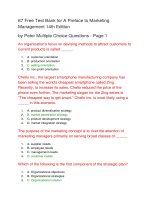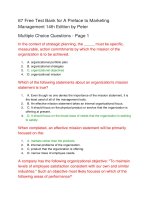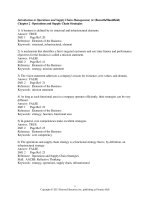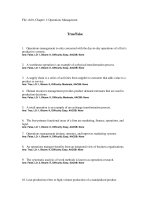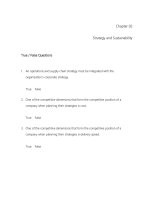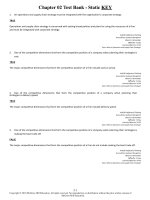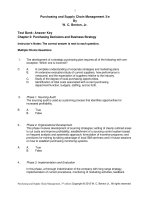Test bank for operations and supply chain management 14th edition f robert jacobs
Bạn đang xem bản rút gọn của tài liệu. Xem và tải ngay bản đầy đủ của tài liệu tại đây (430 KB, 59 trang )
Test Bank For Operations And Supply Chain Management 14th
Edition By F. Robert Jacobs, Richard Chase
Completed download:
Chapter 03
Design of Products and Services
True / False Questions
1. Concept development is one of the typical phases of product development.
True
False
2. Early prototypes of a new product, using the same geometry and material processes as the
production versions, are usually constructed during the concept development phase of the product
development process.
True
False
3-1
3. A key decision point in the generic development process during "Phase 4: Testing and
Refinement" is concept approval.
True
False
4. A key decision point in the generic development process during "Phase 1: Concept Development"
is project approval.
True
False
5. The generic development process outlined in the textbook is followed by many, if not most, of the
firms in the Fortune 500.
True
False
6. Target customers are specified during "Phase 0: Planning" of the generic product development
process.
True
False
7. The main purpose of concurrent engineering is to improve product quality.
True
False
8. Quality function deployment is an engineering analysis whose purpose is to simplify products and
processes.
True
False
3-2
9. Quality function deployment involves listening to customers to determine the characteristics of a
superior product.
True
False
10. Designing a new product for aesthetics and for the user is generally termed industrial design.
True
False
11. One of the methodologies that can aid in designing a new product for customers is a house of
quality matrix.
True
False
12. Value analysis/value engineering has as its objective to increase product quality and reduce
costs.
True
False
13. DFMA stands for design for manufacturing and assembly.
True
False
14. In a concurrent engineering approach to product design and development, an integration team
ensures that various parts of the product are compatible with the needs of the target customer.
True
False
15. A key tool of a quality function deployment team is the house of quality matrix.
True
False
3-3
16. A contract manufacturer is an organization capable of manufacturing and/or purchasing all of the
components needed to produce a finished product or device.
True
False
17. Specialized design firms tend to have highly developed processes that support the needs of
particular industries.
True
False
18. Core competencies are those things that everyone in the firm must be able to do well.
True
False
19. A competency is not core if it is easy for competitors to imitate.
True
False
20. One goal of having a core competency is to do something better than anyone else.
True
False
21. The conclusion of the product development process is when the product is withdrawn from the
market.
True
False
22. In the generic product development process, phase 2 (system-level design) begins with corporate
strategy and incorporates market objectives.
True
False
3-4
23. In the generic product development process, collecting customer needs is accomplished during
phase 0 (planning).
True
False
24. Most purchasers of electronic products cannot fully operate them and use only a small number of
the available features.
True
False
25. The "house of quality" matrix is a technique that relates customer requirements to concrete
operating or engineering goals.
True
False
26. One of the major benefits of DFMA is that products are designed that customers will want.
True
False
27. Incorporation of environmental considerations in the design and development of products or
services is called ecodesign.
True
False
28. Ecodesign replaces one or more of the other requirements considered in the design process.
True
False
29. Because ecodesigned products are innovative and have better environmental performance, they
can be of a slightly lesser quality than the market standard.
True
False
3-5
30. The ecodesign approach focuses exclusively on the design and commercial launch phases of the
product's life cycle.
True
False
Multiple Choice Questions
31. Which of the following is not a typical phases of product development?
A. Concept development
B. Value engineering
C. System-level design
D. Testing and refinement
E. Production/ramp-up
32. Which of the following is a characteristic of concurrent engineering?
A. Integrated computer-assisted design
B. Using automated guided vehicles
C. Separate development teams working at once
D. Having an excellent forecasting system
E. The design-build-test cycle
3-6
33. Which of the following is primarily used to help design products that will connect product attributes
with customer desires?
A. Phase 0: Planning
B. House of quality matrix
C. Value analysis/value engineering
D. Concurrent engineering
E. System-level design
34. Design for manufacturing and assembly delivers product improvements by emphasizing which of
the following?
A. Reducing product quality during the assembly process
B. Simplification of the product by reducing the number of separate parts
C. Reducing equipment in the production process
D. Designing products so they can be manufactured by a virtual factory
E. Designing products that customers will want
35. Which of the following is a time-to-market performance measure used in judging product
development performance?
A. Frequency of new-product introductions
B. Product reliability
C. Customer loyalty
D. Yield
E. Value analysis
3-7
36. What dimension of competitiveness does time-to-market performance in product design and
process selection affect?
A. Engineering hours per project
B. The cost of ongoing service
C. Responsiveness to customer needs
D. Aesthetics of design
E. None of these
37. What dimension of competitiveness does quality in product design affect?
A. Engineering hours per project
B. The cost of ongoing service
C. Responsiveness to customer needs
D. Aesthetics of design
E. None of these
38. A reason that firms must develop more new products than ever is which of the following?
A. Product life cycles are shorter
B. Commitments to joint venture partners
C. They are replacing old customers with new ones
D. To amortize heavy investments in development labs
E. The increased difficulty of defending patents and trade names
3-8
39. Concept development assumes a proven technology in which variant of the generic product
development process?
A. Technology-push products
B. Quick-build products
C. Complex systems
D. Platform products
E. Process-intensive products
40. Similarity of projects allows for a streamlined and highly structured development process in which
variant of the generic product development process?
A. Technology-push products
B. Customized products
C. Complex systems
D. Quick-build products
E. Process-intensive products
41. Sensitivity analysis of the base-case financial model is a useful tool for which of the following
reasons?
A. To determine how long the development process can profitably last
B. To understand how many technical people are needed to make the project a success
C. To help understand the basic trade-offs of resources committed and cash received
D. To identify the necessary product launch date
E. To set marketing and sales budgets
3-9
42. Advocates of financial modeling of product design projects argue that:
A. Financial analysis focuses on measurable quantities only.
B. Financial analysis brings discipline and control to the product development process.
C. Sufficiently rigorous financial analysis can accurately forecast the product's profit potential.
D. Financial analysis is as solid as the assumptions that go into the model.
E. Financial analysis nurtures innovation and creativity.
43. System integration and validation are an important step in which variant of the generic product
development process?
A. Technology-push products
B. Customized products
C. Complex systems
D. Quick-build products
E. Process-intensive products
44. Consumer electronics is an example of a product developed in which variant of the generic
product development process?
A. Technology-push products
B. Customized products
C. Platform products
D. Quick-build products
E. Process-intensive products
3-10
45. The most basic categories of cash flow for a typical new product do not include:
A. Depreciation
B. Ramp-up cost
C. Development cost
D. Sales revenue
E. Marketing cost
46. Economic analysis of product development projects is useful in which of the following
circumstances?
A. Factory location
B. Distribution decisions
C. Go/no-go milestones
D. Demand estimation
E. Pricing
47. Economic analysis of product development projects must evaluate which of the following?
A. Planned profitability of the product
B. Expected market share to be attained
C. Net present value of profits
D. Timing and amount of net cash flow
E. Demand elasticity of the product
3-11
48. Quality function deployment (QFD):
A. Is a manufacturing function aimed at lowering cost by reducing the portion of rejected units.
B. Fills the house of quality matrix with the designer's aspirations for the product.
C. Starts with studying and listening to customers.
D. Is a place where the quality assurance function is housed.
E. Is another term for value engineering.
49. The aim of quality function deployment (QFD) is:
A. To facilitate house of quality analysis
B. To provide value analysis/value engineering input
C. To integrate design for manufacturing and assembly (DFMA)
D. To facilitate better cooperation between business functions
E. To get the voice of the customer into the design of a product
50. The purpose of value analysis/value engineering (VA/VE) is to:
A. Simplify products and processes
B. Improve the value that customers find in existing products
C. Relate the customer's needs to technical specifications
D. Meet budgets and improve the results of financial models
E. Facilitate better cooperation between business functions
Fill in the Blank Questions
3-12
51. What are the six phases of the generic product development process?
1. ______________________________
2. ______________________________
3. ______________________________
4. ______________________________
5. ______________________________
6. ______________________________
________________________________________
52. What seven variants of the generic product development process are discussed in the text?
1. ______________________________
2. ______________________________
3. ______________________________
4. ______________________________
5. ______________________________
6. ______________________________
7. ______________________________
________________________________________
53. What is the name for a matrix that helps a product design team translate customer requirements
into operating and engineering goals? _______________________________________
________________________________________
3-13
54. In product development, what is the analysis called that works toward simplifying products and
processes to achieve equivalent or better performance at lower cost?
________________________________________
________________________________________
55. What are the three characteristics of a core competency?
1. _____________________________
2. _____________________________
3. _____________________________
________________________________________
Essay Questions
56. Describe what rapid prototyping is and where it is particularly useful in the development process.
3-14
57. Describe what concurrent engineering teams are and what problems they address.
58. How might the generic product development process described in the text be different if
developing a process-intensive product?
3-15
Chapter 03 Design of Products and Services Answer Key
True / False Questions
1.
Concept development is one of the typical phases of product development.
TRUE
Our generic product development process consists of six phases, as illustrated in Exhibit 3.1.
The process begins with a planning phase, which is the link to advanced research and
technology development activities. The output of the planning phase is the project's mission
statement, which is the input required to begin the concept development phase.
AACSB: Analytic
Blooms: Remember
Difficulty: 1 Easy
Learning Objective: 03-01 Describe the elements of self concept and explain how they affect an individual's behavior and wellbeing.
Topic: The Product Design Process
3-16
2.
Early prototypes of a new product, using the same geometry and material processes as the
production versions, are usually constructed during the concept development phase of the
product development process.
FALSE
Phase 4: Testing and refinement. The testing and refinement phase involves the construction
and evaluation of multiple preproduction versions of the product. Early prototypes are usually
built with parts with the same geometry and material properties as the production version of the
product but not necessarily fabricated with the actual processes to be used in production.
AACSB: Analytic
Blooms: Remember
Difficulty: 1 Easy
Learning Objective: 03-01 Describe the elements of self concept and explain how they affect an individual's behavior and wellbeing.
Topic: The Product Design Process
3.
A key decision point in the generic development process during "Phase 4: Testing and
Refinement" is concept approval.
FALSE
Concept approval is not part of the generic development process discussed in the text.
AACSB: Analytic
Blooms: Remember
Difficulty: 2 Medium
Learning Objective: 03-01 Describe the elements of self concept and explain how they affect an individual's behavior and wellbeing.
Topic: The Product Development Process
3-17
4.
A key decision point in the generic development process during "Phase 1: Concept
Development" is project approval.
FALSE
Phase 1: Concept Development. In this phase, the needs of the target market are identified,
alternative product concepts are generated and evaluated, and one or more concepts are
selected for further development and testing. A concept is a description of the form, function,
and features of a product and is usually accompanied by a set of specifications, an analysis of
competitive products, and an economic justification of the project. Project approval is not
mentioned.
AACSB: Analytic
Blooms: Remember
Difficulty: 2 Medium
Learning Objective: 03-01 Describe the elements of self concept and explain how they affect an individual's behavior and wellbeing.
Topic: The Product Development Process
3-18
5.
The generic development process outlined in the textbook is followed by many, if not most, of
the firms in the Fortune 500.
FALSE
Some firms define and follow a precise and detailed development process, while others may
not even be able to describe their processes. Every organization employs a process that is
different from that of every other organization; in fact, the same organization may follow
different processes for different product groups.
AACSB: Analytic
Blooms: Remember
Difficulty: 2 Medium
Learning Objective: 03-01 Describe the elements of self concept and explain how they affect an individual's behavior and wellbeing.
Topic: The Product Development Process
3-19
6.
Target customers are specified during "Phase 0: Planning" of the generic product development
process.
TRUE
Phase 0: Planning. The planning activity is often referred to as "phase zero" because it
precedes the project approval and launch of the actual product development process. This
phase begins with corporate strategy and includes assessment of technology developments
and market objectives. The output of the planning phase is the project mission statement,
which specifies the target market for the product, business goals, key assumptions, and
constraints.
AACSB: Analytic
Blooms: Remember
Difficulty: 1 Easy
Learning Objective: 03-01 Describe the elements of self concept and explain how they affect an individual's behavior and wellbeing.
Topic: The Product Development Process
3-20
7.
The main purpose of concurrent engineering is to improve product quality.
FALSE
Traditionally, the attitude of designers has been "We design it; you build it." This has now been
termed the "over-the-wall approach," where the designer is sitting on one side of the wall and
throwing the design over the wall to the manufacturing engineers. These manufacturing
engineers then have to deal with the problems that arise because they were not involved in the
design effort. One way to overcome this problem is to consult the manufacturing engineers
during the design stage. The resulting teamwork avoids many of the problems that might arise.
These concurrent engineering teams require analysis tools to help them study proposed
designs and evaluate them from the point of view of manufacturing difficulty and cost.
AACSB: Analytic
Blooms: Remember
Difficulty: 2 Medium
Learning Objective: 03-01 Describe the elements of self concept and explain how they affect an individual's behavior and wellbeing.
Topic: Designing Products for Manufacture and Assembly
3-21
8.
Quality function deployment is an engineering analysis whose purpose is to simplify products
and processes.
FALSE
One approach to getting the voice of the customer into the design specification of a product is
quality function deployment (QFD).
AACSB: Analytic
Blooms: Remember
Difficulty: 1 Easy
Learning Objective: 03-02 Outline the perceptual process and discuss the effects of categorical thinking and mental models in
that process.
Topic: Designing for the Customer
9.
Quality function deployment involves listening to customers to determine the characteristics of
a superior product.
TRUE
The QFD process begins with studying and listening to customers to determine the
characteristics of a superior product.
AACSB: Analytic
Blooms: Remember
Difficulty: 1 Easy
Learning Objective: 03-02 Outline the perceptual process and discuss the effects of categorical thinking and mental models in
that process.
Topic: Designing for the Customer
3-22
10.
Designing a new product for aesthetics and for the user is generally termed industrial design.
TRUE
Designing for aesthetics and for the user is generally termed industrial design.
AACSB: Analytic
Blooms: Remember
Difficulty: 1 Easy
Learning Objective: 03-02 Outline the perceptual process and discuss the effects of categorical thinking and mental models in
that process.
Topic: Designing for the Customer
11.
One of the methodologies that can aid in designing a new product for customers is a house of
quality matrix.
TRUE
Customer requirement information forms the basis for a matrix called the house of quality. By
building a house of quality matrix, the cross-functional QFD team can use customer feedback
to make engineering, marketing, and design decisions. The matrix helps the team translate
customer requirements into concrete operating or engineering goals. However, the most
important benefit of the house of quality is that it helps the team focus on building a product
that satisfies customers.
AACSB: Analytic
Blooms: Remember
Difficulty: 1 Easy
Learning Objective: 03-03 Discuss how stereotyping; attribution; self-fulfilling prophecy; halo; falseconsensus primacy; and
recency influence the perceptual process.
Topic: Designing for the Customer
3-23
12.
Value analysis/value engineering has as its objective to increase product quality and reduce
costs.
FALSE
The purpose of value analysis/value engineering is to simplify products and processes.
AACSB: Analytic
Blooms: Remember
Difficulty: 1 Easy
Learning Objective: 03-02 Outline the perceptual process and discuss the effects of categorical thinking and mental models in
that process.
Topic: Designing for the Customer
13.
DFMA stands for design for manufacturing and assembly.
TRUE
How does design for manufacturing and assembly (DFMA) work?
AACSB: Analytic
Blooms: Remember
Difficulty: 1 Easy
Learning Objective: 03-02 Outline the perceptual process and discuss the effects of categorical thinking and mental models in
that process.
Topic: Designing Products for Manufacture and Assembly
3-24
14.
In a concurrent engineering approach to product design and development, an integration team
ensures that various parts of the product are compatible with the needs of the target customer.
FALSE
Detail design of the components is a highly parallel process, often referred to as concurrent
engineering, with many separate development teams working at once.
AACSB: Analytic
Blooms: Remember
Difficulty: 2 Medium
Learning Objective: 03-01 Describe the elements of self concept and explain how they affect an individual's behavior and wellbeing.
Topic: The Product Development Process
15.
A key tool of a quality function deployment team is the house of quality matrix.
TRUE
In quality function deployment (QFD), one of the major steps is to determine the product
characteristics that are important to the consumer and to evaluate the firm's product in relation
to others. The end result is a better understanding and focus on product characteristics that
require improvement, Using this information as the basis, a house of quality matrix is
constructed which may be used to improve the product design.
AACSB: Analytic
Blooms: Remember
Difficulty: 1 Easy
Learning Objective: 03-02 Outline the perceptual process and discuss the effects of categorical thinking and mental models in
that process.
Topic: Designing Products for Manufacture and Assembly
3-25
